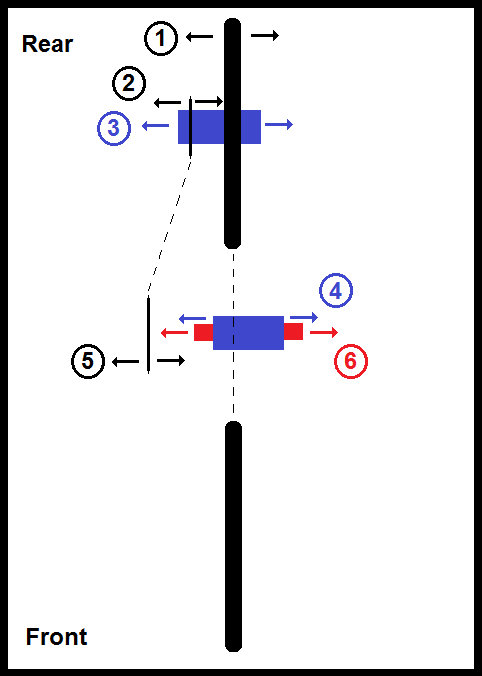by Clint
We've had some questions recently about setting up fixed, single, and other 1x's so I figured I'd shed a little light on the topic in this blog post.
 |
| Example setup: 130mm hub bumped up to 135mm with hub spacers. Spacers and a cassette cog carrier on the freehub. |
There are many factors to consider when setting up a 1x anything, but the one that can be particularly tricky is chainline, or getting a straight line from your chainring to whatever kind of gear you are using in the back. It's going to be less important if you're using multiple gears in the back. In that case, you'll want to shoot vaguely for the middle of the cassette to get the smoothest range of speeds.
Frame Dimensions
If you don't have your hands on a frame already, here are a couple things to keep in mind when finding one to run as a 1x.
- Rear spacing is going to vary for different frames. 130mm is common for road bikes, 135mm for mountain. 126mm is used on old 6- or 7-speed frames, 120mm on 5-speed. You may encounter something else depending on the era and purpose of the frame.
- Fitting your frame to your hub - If you're using a hub that doesn't match up with the rear of your frame, you can often stretch or squish the frame to make it fit your needs. I can't guarantee this will work, but if you try it, just make sure both sides of the frame are repositioned evenly. Otherwise you'll have to get fancy with your wheel dishing. I'd also discourage you from doing this if you have anything other than a steel frame. The mismatched hub and frame can still work even if you don't permanently set the frame; however, it may take a little longer to get your wheel back in.
- Fitting your hub to your frame - Alternatively, if you're bumping up to a larger size from your hub to your frame and don't want to stretch your frame, you can sometimes put spacers in your hub (depending on your hub). I used a couple of spacers in my hub to bump it up from a 130mm to a 135mm. This isn't possible on all hubs. For instance, our cassette hubs are set up for easy freehub body removal, so spacers would mess things up.
- Dropouts - As far as this blog post is concerned, dropouts fall into two categories:
- Horizontal dropouts allow for variation in the horizontal distance. I'm including semi-horizontal, forward facing, and rear facing in this category. These dropouts are going to make adequate chain tension easy since you can adjust it by simply moving your wheel forwards or backwards.
- Vertical dropouts - With these, you don't have horizontal variation. These are good for disc brakes or an aesthetically pleasing fenderline. If you have vertical dropouts, you have two options:
- Use a chain tensioner or a rear derailleur if using multiple speeds in the back. These aren't going to work for fixies.
- Do the math. Figure out the distance between your gears and use their diameters to calculate the length of the required chain. Make sure this length of chain is either a multiple of 1in if you're using a regular chain or .5in if you're using a half link chain. Next, pray that your chain doesn't stretch too much after a few days of use. Keep in mind that different gear combos can yield the same, if not close, ratio. Park Tool has an approximation of the formula here. Helpful hint: CAD programs can do the math for you.
 |
| Calculate the required chain length (red) with these measurements. |
Hub Types
- For a 1x multiple, just aim to have your chainline somewhere close to the middle of your cassette. Check the top and lowest gears to make sure your chainline isn't too extreme.
- For single speeds with a cassette hub, I'd recommend something like the Problem Solvers cassette cog carrier. You'll need some spacers and the threaded end piece of a cassette to line up and keep your cog in place. You can use bottom bracket spacers, spacers from an old cassette, or something else of a similar size.
- For fixed or free hubs, you won't be able to adjust cog/freewheel in relation to the hub (see #2 below).
- Note: With a spacer, you can use either side of our fixed/free hubs for a cog or freewheel. Additionally these hubs come with spacers for different frames sizes.
- Adjusted with dish.
- In a cassette setup, adjusted with spacers. In a fixed/free setup, this can't be adjusted.
- Adjusted using spacers or if the hub uses a cup and cone.
- Adjusted a little bit in the bottom bracket shell with the use of bottom bracket spacers.
- If using a crank intended for multiple chainrings, you can decide which position is best for chainline. Line up 3 with 5.
- With traditional bottom brackets you can change out the spindle or rotate to get a different length. In modern cartridge style bottom brackets, you can experiment with different length spindles.
RIDE FIXED OR whatever.
Clint





4 comments:
Next, pray that your chain doesn't stretch too much after a few days of use.
My gods don't listen such selfish prayers, but really. How much "chain stretch" will you get a a few days without a grinding compound on your chain?
Praying to Eddie Merckx has gotten me out of a few tight situations. I mostly want people to be aware that the setup with vertical dropouts isn't a perfect one and chain stretch can be one of the sources of uncertainty.
Can you tell me if the fixed hub is a standard 42 mm chainline for the fixed side??
It is 42mm chainline.
Post a Comment